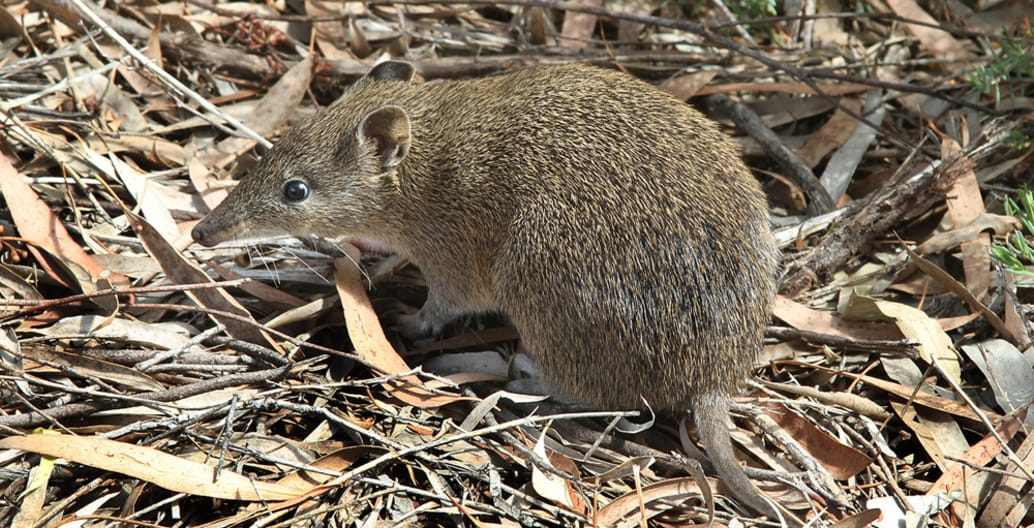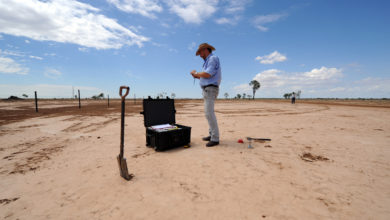
Endangered bandicoots survive and thrive in urban sprawl
Research is showing that bandicoots can adapt to living well in urban infrastructure corridors. It’s time to rethink urban design priorities. Catering for wildlife by providing linear green strips makes our lives richer too.
Habitat loss and modification through urbanisation is a major contributor to wildlife extinction around the world. Certain species, however, have been able to adapt to the ecologically novel environments provided by cities and peri-urban landscapes. Urban green spaces and habitat links play an important role in the provision of habitat for native species. Southern brown bandicoots are nationally endangered but despite their populations suffering during processes of landscape modification, they have adapted remarkably well to the peri-urban landscapes of greater Melbourne.
The southern brown bandicoot is something of a poster species for the struggles between wildlife and urbanisation. Although once widespread in Melbourne’s southeast, bandicoots are largely absent from developed urban areas, yet they have retreated to suitable habitat throughout peri-urban landscapes where they appear to be readily adapting. Researchers at the Centre for Integrative Ecology at Deakin University studied the movement ecology of bandicoots within a peri-urban landscape in the west Gippsland region of the outskirts of Melbourne. The study focused on a population of bandicoots occupying the former Koo Wee Rup swamp, which was drained during the 1870s for agricultural use and to streamline access to Melbourne. Part of Melbourne’s ‘Greater Capital City Statistical Area’, this urban growth corridor includes a large population of human commuters, which reflects the functional extent of the city.
Once considered common, bandicoots have suffered severe population declines due to habitat loss and modification, isolation, as well as an increase in vulnerability to introduced predators. Their former natural range extended from coastal fringes of Victoria through to NSW, as well as southern Western Australia and South Australia, Tasmania and northern Queensland. They now occupy a fraction of that area.
The Centre for Integrative Ecology researches the factors driving both immediate and evolutionary responses to a changing environment. PhD candidate Sarah Maclagan, alongside Dr Euan Ritchie, whose field of expertise includes the ecology, conservation and management of Australian mammals, worked with resident ecologist at Cranbourne Royal Botanic Garden, Terry Coates, to uncover the movement ecology of urban populations of the southern brown bandicoot.
Research found that while bandicoot populations had suffered badly during the process of urban development, they made good use of available vegetation, particularly along infrastructure corridors such as those reserved for present and future waterways, electricity, gas, sewer, drainage and transport. Linear vegetation strips offer an under-appreciated conservation value by facilitating connectivity or providing new ecological niches in a modified landscape. The vegetation concentrated in these strips may be remnant original species or revegetation, and can include exotic species such as blackberry.
The novel habitat provided by linear vegetation strips was found to support higher bandicoot numbers than vestigial habitat fragments, even where human impact was less by comparison. As well as supporting a higher number of bandicoots than first thought, resident female bandicoots were surprisingly healthy. Female bandicoots generally do not travel as much as their polygamous male counterparts, but those occupying linear vegetation sported robust body condition. This indicates that despite the higher numbers of bandicoots, linear habitat strips provided equivalent, if not superior food and shelter resources to that of larger, unmodified habitat fragments.
Like any animal, bandicoots require a minimum habitat area to meet their fitness needs. Resident bandicoots in linear vegetation strips readily adopted a more elongated home range, and the length of home ranges reduced with increasing strip width. Access to more stable food resources in smaller areas is associated with urban wildlife populations globally. This is likely contributing to the smaller home ranges and higher densities of bandicoots. High proportions of individuals were ‘residents’ in linear sites, sometimes staying up to 17 months before moving to seek further access to resources and mates. This is a significant proportion of time for an animal whose lifespan is three to four years and confirms that novel linear sites are not only providing short-term movement corridors between larger sites, but are of sufficient habitat quality to support residence.
Landcare Australia ran a large community meeting in the town of Bunyip to raise awareness of local bandicoot numbers. In conjunction with Sarah Maclagan from Deakin University and other environmental groups, the meeting outlined bandicoot adaptation to the growing urbanisation and development in the area. Branch president Susan Anderson says there were over 80 attendees at the meeting. “The high number of bandicoots in Bunyip were described by David Nicholls of Westernport Biosphere as ‘an aberration’, which is why we had the meeting in the first place,” explains Anderson. The Westernport Biosphere Foundation is a non-profit organisation that works with communities to create an environmentally, economically and socially sustainable future for the region based on scientific research. “After that meeting at least people recognised them!” added Anderson.
However, community awareness may not necessarily improve the conservation of wildlife species in urban environments. Cardinia Shire Council, the local government body for the research area, have a ten-year-old strategic management plan on their website, complete with a ‘how to’ guide for the general public to build bandicoot shelters in their backyards. Anderson suspects many people don’t report sightings of bandicoots. “Some people don’t report them because they don’t want the authorities to know they were on their property, in case they couldn’t subdivide or have more dogs and so on.”
With unprecedented tracts of Australia’s natural bushland being cleared for livestock and broad-scale agriculture, the green spaces provided in and around urban centres are increasing in ecological value. Nicholls found that bandicoots are only one of a number of species that have been able to withstand the impacts of urban growth and have maintained populations on the outskirts of major cities. But simply providing green spaces isn’t enough as a stand-alone, long-term solution. To successfully provide usable habitat, a whole ecosystem must be considered, rather than individual species and individual sites. The landscape must be considered as a checkerboard, a matrix of built-up patches interspersed with green spaces, as well as linkages in between. Only this will help threatened species such as the southern brown bandicoot.
Cardinia Shire Council has an Environmental Significance Overlay for the southern brown bandicoot. Council’s website explains that “a number of developers have cleared bandicoot habitats on a site by site basis, therefore creating gaps in movement corridors. The current ad hoc pattern of subdivisions has led to some properties having no or inadequate provision of habitat for the species, while other properties have variable width corridors and inconsistent management requirements”. But Anderson says it’s been too little too late. “The overlay is too late and offset arrangements are inadequate. We are looking for sites of at least five hectares for offset works under the EPBC Act.”
Human presence creates risks for animals, and they tend to move less as the human footprint on the landscape strengthens. But the advantages and disadvantages for urban animal populations can be considered when planning human communities. The shape, size and quality of habitat are determined by the composition of the broader landscape matrix. Understanding how linear vegetation corridors impact the way animals move and use space can provide valuable information for the management of biodiversity, as well as the maintenance of viable wildlife populations in and around urban centres. This information can be used when planning and designing modified landscapes to establish minimum size, shape and connectivity of remnant vegetation, as well as planned revegetation.
Several design, planning and management suggestions were made by the team at Deakin for the ongoing conservation of bandicoot populations within expanding urban development areas. Vegetated strips along both sides of linear infrastructure should be established and maintained at a minimum of 30 metre width on both sides. They found adult bandicoots were unable to pass bitumen roads or deep waterways, and juveniles had great difficulty trying to disperse in search of new territory. In these cases, culverts and crossing structures could connect habitat, as well as reduce potential human-wildlife conflict. Bandicoots were found to persist in strips as narrow as 16.5 metre and so narrower strips of vegetation should also be considered as suitable, if less desirable, habitat. Ideally, vegetation strips should be continuous for at least 500m to allow space for at least one male and two female home ranges, and culverts again should be considered to allow for dispersal.
Weeds can provide shelter and food resources for bandicoots as well as other small animals, and removal programs can impact heavily on their wellbeing. Weed control should be gradual and exotic weeds should be replaced with fast growing native species to allow for swift replacement of niche resources. Planting dense understory in private gardens and as well as public spaces can enhance the permeability and habitat value of the matrix, however, a shift in public attitude is needed here. Continuous habitat is enhanced by permeable private fences that allow movement through shelter belts. Again, an adjustment in community approach to wildlife on private properties needs to be encouraged. Anderson suggests that rather than back-to-back yards, providing a corridor of 20 metre width behind homes would create new usable habitat. “Better this than nature strips. That way the bandis are away from vehicles,” says Anderson.
The number of introduced predators, including pets, rises significantly in urban areas. This, combined with weed mismanagement can significantly increase the bandicoot’s vulnerability. Feral animal control, such as the reduction of fox and rabbit numbers should also be conducted using an integrated, whole-of-ecosystem approach to avoid potential negative impacts. “Plant low shrubs and ground covers, and provide predator proof shelters,” Anderson adds. “And consider blackwoods for occasional shade trees as they are less fire prone.”
Novel habitats in our expanding suburbs can offer unique conservation opportunities, particularly when species are able to adapt to and exploit them. “They are very adaptive and will happily live under blackberries and old car bodies,” Anderson says of bandicoots smiling. “They’re the trailer trash of endangered species really!”
Successful habitat continuity for any species relies more on close initial collaboration with council and developers than on community interest after animal populations have already dwindled. An integrated, whole-of-ecosystem approach is also more effective in preserving species on site than recreating entirely new habitats, regardless of how adaptable they are. Careful consideration of habitat requirements from the start of planning for subdivisions will obviously reduce the impact of habitat modification. This includes factoring in consideration of both land shape and connectivity, as well as vegetation make-up. Finally, ongoing population monitoring will assist with understanding how bandicoots are coping in new land developments. These approaches have tremendous potential for helping other species made vulnerable by urbanisation. It will also make our new homes rich places for us to grow too.
–
Lucy Smith holds a Master of Environmental Science, specialising in forest community ecology. Her interests span a range of ecological areas, including natural asset management in agriculture and the interaction between humans and wildlife.


